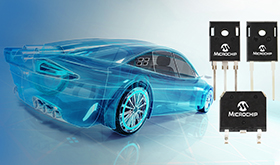

As vehicle electrification continues rapid growth worldwide, innovative power technologies such as silicon carbide (SiC) are required for high-voltage automotive systems ranging from motors to on-board charging and DC/DC converters. Microchip Technology recently announced its newly-qualified 700 V and 1200 V SiC Schottky barrier diode (SBD) power devices, providing electric vehicle (EV) system designers with solutions that meet stringent automotive quality standards across a wide range of voltage, current and package options.
For EV power designers who need to increase system efficiency while maintaining high quality, Microchip’s AEC-Q101-qualified devices maximise system reliability and ruggedness and enable stable and lasting application life. The devices’ superior avalanche performance allows designers to reduce the need for external protection circuits, reducing system cost and complexity.
Microchip has been a supplier to the automotive industry for more than 25 years. The company’s SiC technology, as well as its multiple IATF 16949:2016-certified fabrication facilities, provides high-quality devices through flexible manufacturing alternatives, helping minimise risk in the supply chain.
Through Microchip internal and third-party testing, critical reliability metrics have proven Microchip devices’ superior performance when compared to other SiC manufactured devices. Unlike other SiC devices that degrade under extreme conditions, Microchip devices have demonstrated no degradation in performance, increasing the application life. Microchip SiC solutions lead the industry in reliability and ruggedness.
The company’s SiC SBD ruggedness testing demonstrates 20 percent higher energy withstand in unclamped inductive switching (UIS), and among the lowest leakage currents at elevated temperatures, increasing system life and enabling a more reliable operation.
Microchip’s SiC automotive power devices complement its broad portfolio of controllers, analog and connectivity solutions, providing designers with total system solutions for electric vehicles and charging stations. Microchip also provides a broad portfolio of 700 V, 1200 V and 1700 V SiC SBD and MOSFET power modules utilising its newest generation of SiC die.
In addition, its dsPIC digital signal controllers deliver performance, low power consumption and flexible peripherals. Microchip’s AgileSwitch family of digital programmable gate drivers further accelerates the process of moving from the design stage to production. These solutions also have applications across renewable, grid, industrial, transportation, medical, data centre and aerospace and defence systems.
Microchip’s AEC-Q101-qualified SiC SBD devices are supported with SPICE and PLECS simulation models and MPLAB Mindi Analog Simulator. Also available is a PLECS reference design model that uses Microchip’s SBDs (1200 V, 50 A) as part of the power stage – the Vienna three-phase power factor correction (PFC) reference design.
| Tel: | +27 11 923 9600 |
| Email: | [email protected] |
| www: | www.altronarrow.com |
| Articles: | More information and articles about Altron Arrow |

© Technews Publishing (Pty) Ltd | All Rights Reserved